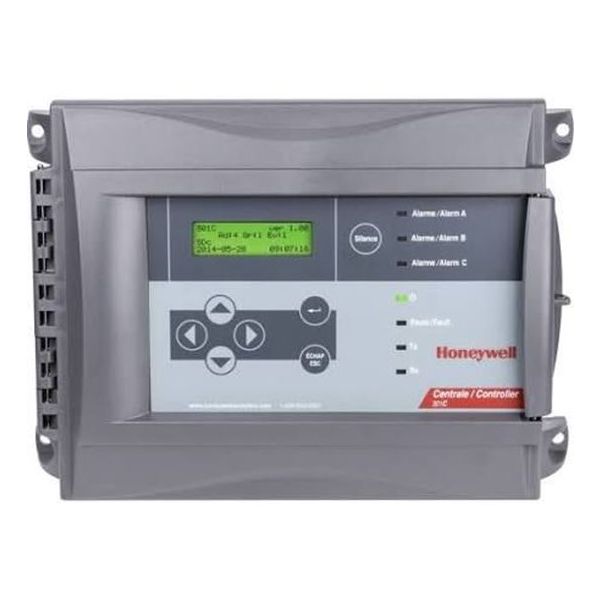301-C Honeywell Analytics Gas Detection Control
The Honeywell Analytics 301-C is a gas detection control unit designed to provide comprehensive monitoring and control for a wide range of toxic and combustible gases. It acts as the brain of your gas detection system, coordinating with various sensor types to deliver crucial safety and operational insights. It connects and manages up to 96 transmitters across three channels, allowing you to track diverse gas hazards simultaneously. It works with a variety of Honeywell Analytics gas sensors, including toxic, combustible, and oxygen sensors, giving you flexibility to tailor your system to specific needs. The 301-C Honeywell Analytics gas detection control translates sensor readings into actionable information, displays data on its clear LCD screen, and triggers alarms when gas levels reach dangerous thresholds.
Key Features:
- Weight: 3.12lbs/1415.21g.
- Control and Automation: Activates ventilation systems, shuts down equipment, or initiates other safety measures in response to gas leaks, improving safety and process efficiency.
- User-Friendly Interface: Intuitive buttons, clear visuals, and multilingual support make the 301-C easy to operate and understand for various personnel.
- Rugged and Reliable: Built to withstand harsh industrial environments and demanding applications.
- Multiple Mounting Options: Wall or duct mounting allows for optimal placement in various setups.
Signs of Faulty Honeywell Analytics Gas Detection Control
Recognizing potential issues with the Honeywell Analytics 301-C gas detection control unit is crucial for maintaining safety and optimal system performance. Here are some signs that could indicate a fault:
Performance Issues:
- Erratic gas readings: Fluctuations in displayed gas levels across different channels or inconsistent readings compared to sensor specifications might suggest sensor or control unit malfunction.
- Unrealistic gas readings: Values outside the expected range for connected sensors could indicate calibration issues, sensor failure, or communication problems.
- Failure to respond to gas changes: If the 301-C doesn't register changes in gas levels despite known exposure, it might be faulty or require reconfiguration.
- False alarms or malfunction indicators: Erroneous alarms triggered without actual gas leaks or system error messages requiring attention point towards potential faults.
- Slow response time: The unit taking longer than usual to process readings and activate alarms might indicate internal issues or communication problems.
Display and Output Issues:
- Dimmed or malfunctioning display: Issues with the display backlight, flickering or missing digits, or abnormal visuals could indicate internal issues within the 301-C.
- Unexpected output signal changes: Erratic relay triggers, analog signal variations, or communication errors might suggest control unit malfunctions.
- Communication failures: Lack of response to operator commands, data transmission errors between the 301-C and other system components, or loss of connection with connected sensors can indicate communication problems.
Sensor Related Issues:
- Expired or damaged sensor cartridges: Sensor cartridges have limited lifespans and physical damage can affect their accuracy and functionality.
- Incorrectly installed or seated cartridges: Improper installation can disrupt communication and readings.
- Incompatible sensor cartridges: Using the wrong cartridge for the gas you need to detect will provide inaccurate readings.
Additional Considerations:
- Frequent calibration needed: If the 301-C or connected sensors require calibration more often than recommended, it could be nearing the end of its lifespan or have internal issues.
- Physical damage: Visible cracks, corrosion, or contamination on the control unit housing, connections, or display can affect performance and reliability.
- Changes in baseline readings: Consistent shifts in the baseline gas readings over time might indicate sensor drift, calibration issues, or environmental factors.
Choose the best HVAC equipment parts and supplies from PartsHnC!
-
Same Day Shipping
-
Best Quality And Best Price
-
Wide Range of Inventory
-
Best Customer Service
Have More Questions or Need Help to Place The Order?
Reach us at (866)773-0907 or [email protected]
FAQs
What does 301-C gas detection control do?
Think of the 301-C as the brains of your gas detection system. It's the control unit that gathers information from different gas sensors (like toxic, combustible, and oxygen), interprets the data, and triggers alarms or activates safety measures when gas levels get dangerous.
What gases can Honeywell Analytics gas detection control detect?
It's flexible! With the right sensor cartridges, it can sniff out a variety of threats, from common culprits like carbon monoxide and nitrogen dioxide to more specific gases like hydrogen sulfide and methane.




